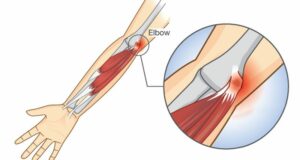Living with elbow pain can be more than just a minor inconvenience; it can affect every aspect of your daily life, from brushing your teeth to carrying groceries. If you’re among the many individuals suffering from elbow discomfort, don’t despair. This blog post aims to guide you through the anatomy of elbow pain, its various causes, and the treatments that can help restore your mobility and comfort.
Contents
Is Elbow Pain Serious?
 The seriousness of elbow pain can vary greatly depending on the underlying cause. In many instances, this can be a temporary nuisance resulting from a minor strain, overuse, or a simple bump. This type of pain generally subsides with rest and over-the-counter pain relievers. However, if the pain persists for more than a few days, becomes progressively worse, or is accompanied by other worrying symptoms, it’s important to seek medical attention.
The seriousness of elbow pain can vary greatly depending on the underlying cause. In many instances, this can be a temporary nuisance resulting from a minor strain, overuse, or a simple bump. This type of pain generally subsides with rest and over-the-counter pain relievers. However, if the pain persists for more than a few days, becomes progressively worse, or is accompanied by other worrying symptoms, it’s important to seek medical attention.
Certain conditions like tennis elbow, golfer’s elbow, or arthritis can lead to chronic elbow pain. And could potentially limit one’s mobility or overall quality of life if left untreated. While not all pain is serious, persistent, or severe should not be ignored and should be evaluated by a healthcare provider.
What Are The Symptoms To Know?
Symptoms of elbow pain can vary significantly depending on the cause and severity of the condition. Here are some of the common symptoms:
- Aching or Sharp Pain
This can occur either at rest or during movement and can be localized to the elbow or radiate to the forearm or hand.
- Swelling and Redness
This might be noticed around the elbow joint, indicating inflammation or infection.
- Tenderness to Touch
The area around your elbow might be sensitive or painful to the touch.
- Decreased Range of Motion
You might have difficulty bending or straightening your arm, or find certain movements particularly painful.
- Weakness
You may notice difficulty or inability in gripping objects, opening jars, or lifting items.
- Numbness or Tingling
This can occur in the elbow, forearm, or fingers, and may indicate nerve involvement.
- Locking or Catching Sensation
This sensation can suggest a problem with the joint itself, such as a loose piece of cartilage or bone.
- Warmth
The skin over the elbow may feel warm to the touch, suggesting inflammation or infection.
If you are experiencing any of these symptoms and they are persistent, worsening, or accompanied by other worrying signs. Then, it’s important to consult a healthcare provider for further evaluation and treatment.
What Are The Main Causes Of Elbow Pain?
 Elbow pain can be caused by a variety of conditions, typically resulting from overuse, injury, or age-related wear and tear. Here are some of the common causes:
Elbow pain can be caused by a variety of conditions, typically resulting from overuse, injury, or age-related wear and tear. Here are some of the common causes:
- Tennis Elbow (Lateral Epicondylitis): This is caused by overuse of the forearm muscles and tendons. Eventually, leading to inflammation and pain on the outer side of the elbow.
- Golfer’s Elbow (Medial Epicondylitis): Similar to tennis elbow, pain, and inflammation occur on the inner side of the elbow. It’s often due to excessive use of the muscles in the wrist and fingers.
- Olecranon Bursitis: This occurs when the small fluid-filled sac (bursa) at the back of the elbow becomes inflamed, often due to injury or prolonged pressure.
- Osteoarthritis: This degenerative joint condition can also affect the elbow, causing pain, stiffness, and reduced range of motion.
- Rheumatoid Arthritis: This is an autoimmune disease that can affect any joint in the body. Including the elbow, causing pain and inflammation.
- Cubital Tunnel Syndrome: This condition is caused by increased pressure on the ulnar nerve. That passes close to the skin’s surface in the area of the elbow commonly known as the “funny bone.”
- Elbow Fractures or Sprains: These can occur due to a fall, a direct blow to the elbow, or an awkward twist or bend of the elbow joint.
- Elbow Dislocation or Subluxation: This typically results from trauma, such as a fall or a blow to the elbow.
- Tendinitis: Inflammation or irritation of a tendon, often due to repetitive motions, can cause elbow pain.
- Cellulitis: This bacterial skin infection can cause pain, redness, and swelling in the affected area.
It’s important to seek professional medical advice if you’re experiencing persistent or severe elbow pain to determine the underlying cause and appropriate treatment.
How Is It Diagnosed?
The process of diagnosing the cause generally begins with a thorough medical history and physical examination. Here’s a brief overview of the typical steps a healthcare provider may take:
1. Medical History
Your doctor will begin by asking about the characteristics of your pain (when it started, where exactly it hurts, what makes it better or worse), any injuries or activities that may have triggered it, and any associated symptoms.
2. Physical Examination
Your healthcare provider will examine your elbow, looking for signs of swelling, redness, warmth, or deformity. They may also palpate (feel) the area to identify any areas of tenderness. They’ll likely ask you to move your elbow in various ways to assess your range of motion and to identify movements that cause pain.
3. Imaging Tests
If the cause of your elbow pain is not clear after the medical history and physical examination, your doctor may order imaging tests. These can include:
- X-rays: These can reveal fractures, arthritis, and other bone abnormalities.
- MRI (Magnetic Resonance Imaging): This provides a more detailed image and can help diagnose damage to soft tissues. Such as muscles, ligaments, tendons, and cartilage.
- Ultrasound: This can help visualize soft tissue structures. And can also be used in cases of suspected fluid accumulation.
4. Nerve Conduction Studies
If nerve involvement is suspected (as in cases of cubital tunnel syndrome), nerve conduction studies may be used to measure the speed. And the strength of signals passing through your nerves.
5. Blood Tests
If your doctor suspects an infection or a condition such as rheumatoid arthritis. Then, they may order blood tests to look for markers of inflammation or specific antibodies.
6. Aspiration or biopsy
In rare cases, your doctor may need to take a sample of fluid or tissue from your elbow for further analysis. This can help identify infections, gout, or tumors.
The specific diagnostic steps can vary depending on your individual symptoms and circumstances. It’s important to consult a healthcare provider if you have persistent or severe elbow pain.
How Do You Relieve Elbow Pain?
 Relief from elbow pain can often be achieved through a combination of self-care measures and medical treatments. Here are some general strategies:
Relief from elbow pain can often be achieved through a combination of self-care measures and medical treatments. Here are some general strategies:
Self-Care Measures
- Rest: One of the first steps in relieving elbow pain, especially if it’s due to overuse, is to rest the affected arm and avoid activities that exacerbate the pain.
- Ice and Heat: Applying ice to the elbow can help reduce inflammation and numb the area, providing temporary pain relief. After the first 48-72 hours, when the inflammation has subsided, heat can help relax and loosen tissues, reducing pain.
- Compression: Wrapping the elbow with an elastic bandage can provide support and help reduce swelling.
- Elevation: Keeping your elbow elevated above the level of your heart can help decrease swelling and pain.
- Pain Relievers: Over-the-counter nonsteroidal anti-inflammatory drugs (NSAIDs). Such as ibuprofen or naproxen, can reduce both pain and inflammation.
Medical Treatments
- Physical Therapy: A physical therapist can provide exercises and stretches to improve flexibility, strength, and range of motion. They can also provide techniques for pain management and prevention.
- Corticosteroid Injections: For severe or persistent pain, your doctor might recommend a steroid injection to reduce inflammation and provide relief.
- Surgery: In rare cases, if conservative treatments fail and pain persists, surgery might be necessary to repair damage to tendons, nerves, or joints.
- Occupational Therapy: An occupational therapist can provide strategies and modifications for daily activities to reduce stress on the elbow and manage pain.
Remember, it’s essential to consult a healthcare provider for an accurate diagnosis if you have persistent or severe elbow pain. They can guide you to the most appropriate treatment for your condition.
Conclusion
In conclusion, elbow pain, though common, should never be taken lightly. Understanding the various causes, symptoms, and treatments is a key step toward managing and ultimately overcoming this discomfort. It’s important to remember that while some cases of elbow pain may resolve with simple home remedies. And, others may require professional medical intervention.
With the right treatment approach tailored to your specific condition, you can regain your strength, and flexibility, and return to your normal daily activities. So, take charge of your health, and remember – your journey to a pain-free life begins with a single step.
If you’re experiencing Elbow pain, physical therapy for elbow pain at PhysioMantra can help: Book an online physical therapy session.


